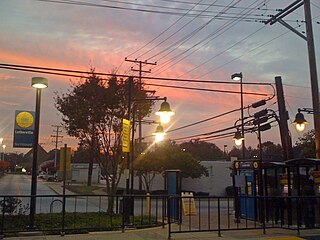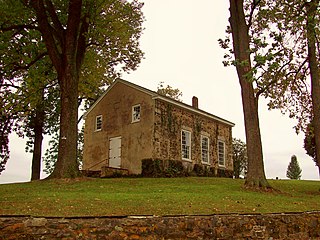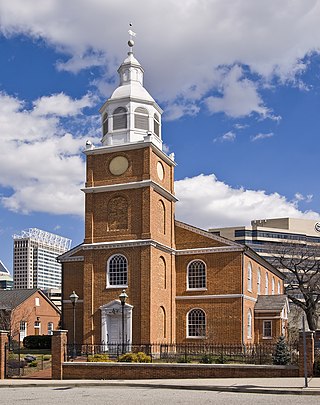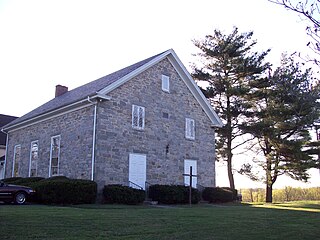
Elkridge is an unincorporated community and census-designated place (CDP) in Howard County, Maryland, United States. The population was 15,593 at the 2010 census. Founded early in the 18th century, Elkridge is adjacent to two other counties, Anne Arundel and Baltimore.

Mount Vernon is a neighborhood of Baltimore, Maryland, located immediately north of the city's downtown. It is named for George Washington's Mount Vernon estate in Virginia, as the site of the city's Washington Monument.

Lansdowne is a census-designated place in southern Baltimore County, Maryland, United States, located just south of Baltimore. As of the 2010 census, it had a population of 8,409. At the 2000 census and earlier, the area was delineated as part of the Lansdowne-Baltimore Highlands CDP.

Darlington is an unincorporated community and census-designated place in northeastern Harford County, Maryland, United States. The population was 409 at the 2010 census. The center of the community was listed on the National Register of Historic Places as the Darlington Historic District in 1987. Median household income is $66,563. The percentage of people in poverty is 5.3%.

Lutherville is a census-designated place (CDP) in Baltimore County, Maryland, United States. As of the 2010 census it had a population of 6,504. Prior to 2010 the area was part of the Lutherville-Timonium CDP. Within its borders lies the Lutherville Historic District.

The Perry Hall Mansion is a historic structure located in the area to which it gave its name, Perry Hall, Baltimore County, Maryland, United States. Erected on a hill above the Gunpowder River Valley, the mansion is an excellent example of late colonial and early 19th-century life in eastern Baltimore County.

Towson United Methodist Church is a large United Methodist Church in the historic Hampton subdivision of Towson, a suburb in Baltimore County, Maryland. Its past, rooted in 19th-century America and subsequent growth in the two centuries since then, has closely paralleled the nation's political and sociological trends. It was a congregation split asunder in 1861 on the eve of the American Civil War in a border state of divided loyalties, which eventually reunited and built a church in the post–World War II era of the 1950s, a time of reconciliation and rapid growth by mainline Protestant denominations, especially in the more affluent suburbs.

The Kelso Home for Girls, formerly the Kelso Home and Orphan Asylum in Baltimore, Maryland, was a 19th-century orphanage and school building for girls on East Baltimore Street in the Jonestown/Old Town neighborhood, east of the Jones Falls. It was founded by businessman and philanthropist Thomas Kelso, (1784–1878), a former member of the old Methodist Episcopal Church, and inaugurated in January 1874. Formerly the Towson Family YMCA, it is now the Y of Central Maryland Towson Family Center.

Geeting Farm is a historic home located at Keedysville, Washington County, Maryland, United States. It is a two-story, five-bay log dwelling resting on low fieldstone foundations, with a one-story, three-bay stone addition. Numerous sheds and outbuildings are located near the house. The house was built by George Adam Geeting [1741-1812], who settled on this land near Little Antietam Creek after immigrating to the English Colony of Maryland in 1759 from his native Prussia. Geeting farmed his land and taught in a log schoolhouse nearby which became a regular preaching appointment for services held by Rev. Philip William Otterbein, one of the founding leaders of the United Brethren in Christ, the first denomination organized in the United States of America. In the mid-1770s, Geeting erected a meetinghouse which later became known as Mount Hebron Church, the first structure built expressly for services of the future United Brethren in Christ denomination. Salem United Methodist Church in Keedysville is the successor to the Mount Hebron Church and Geeting Meetinghouse. Getting himself was ordained a minister of the German Reformed Church in 1788 and traveled extensively through Western Maryland, Virginia, and Pennsylvania as an itinerant preacher. On September 25, 1800, George Adam Geeting attended the first conference of the United Brethren in Christ at the home of Peter Kemp near Frederick, Maryland. It was at this conference that the United Brethren in Christ was formally organized as a denomination and took its name. Geeting continued serving as a minister for the new church, acted as secretary of the denominational conference, and served as a bishop of the United Brethren in Christ briefly in 1812 before his death.

Thomas Run Church, also known as Watters Meeting House, is a historic Methodist church located at Bel Air, Harford County, Maryland. It is a one-story, rubble stone, three-bay church with a slate-covered gabled roof. It was among the first structures used by Methodists in colonial America.

Johnsville is an unincorporated community in Frederick County, Maryland, United States. It is located approximately halfway between Libertytown and Union Bridge along Maryland Route 75. The Kitterman-Buckey Farm was listed on the National Register of Historic Places in 2005.

Otterbein Church, now known as Old Otterbein United Methodist Church, is a historic United Brethren church located in Baltimore, Maryland, United States. The first "German Reformed" church was built to serve the German Reformed and some Evangelical Lutheran immigrants, and later entered the Brethren strain of German Reformed Protestantism in the later Church of the United Brethren in Christ.

Orchard Street United Methodist Church, formerly known as Metropolitan Methodist Episcopal Church, is a historic Methodist Episcopal church located at Baltimore, Maryland, United States. It is a church built in a mixture of revival styles. It was constructed in 1837, with additions made in 1853, 1865, and 1882. The main church is Romanesque Revival, but the rear building is Romanesque with a large Gothic window in its northeastern facade. The nave is approximately 54 by 75 feet and features clerestory windows. The rear building is approximately 50 by 75 feet. The church was founded in 1825 by Truman Le Pratt, a West Indian former slave of Governor John Eager Howard. It now houses the offices of the Baltimore Urban League and is the oldest standing structure built by African-Americans in the city of Baltimore.

Sharp Street Memorial United Methodist Church and Community House is a historic United Methodist church located at Baltimore, Maryland, United States. It is an 1898 Gothic Revival stone structure of massive proportions. It features sharply pitched gables, a square parapeted 85-foot-high bell tower, lancet windows, and Gothic influenced interior decorative detailing. The Community House is a Georgian Revival influenced brick structure, four stories high and built in 1921. The congregation was organized in 1787 and was highly influential in the antebellum freedom movement, the establishment of the first black school in Baltimore after the abolition of slavery, and the movement to foster the institution of the African American Methodist church. It is known as the "Mother Church" of Black Methodism in Maryland. The National Association for the Advancement of Colored People, during their formative years, held their meetings at this historic church.

Green Spring Valley Historic District is a national historic district near Stevenson in Baltimore County, Maryland, United States. It is a suburban area of Baltimore that acquires significance from the collection of 18th, 19th, and early 20th century buildings. The park-like setting retains a late 19th-early 20th century atmosphere. At the turn of the 20th century, the Maryland Hunt Cup and the Grand National Maryland steeplechase races were run over various parts of the valley. The Maryland Hunt Cup, which began as a competition between the Green Spring Valley Hunt and the Elkridge Hunt, traditionally started at Brooklandwood, the previous home of Charles Carrol of Carrollton with the finish across Valley Road at Oakdene, at that time the home of Thomas Deford, which remains a private residence

The Easton Historic District is a historic district that covers most of the core of the town of Easton, Maryland. The town is the county seat of Talbot County. The state of Maryland is nearly split by the Chesapeake Bay, and Easton is located on the east side of the bay that is known as Maryland's Eastern Shore. Although the town is part of the east coast of the United States, the region's history goes back to a time when Maryland was a colonial province of England.
The Allegheny Wesleyan Methodist Connection (AWMC), originally the Wesleyan Methodist Church (Allegheny Conference), and also known as the Wesleyan Methodist Church (WMC), is a Methodist denomination within the conservative holiness movement primarily based in the United States, with missions in Peru, Ghana, and Haiti.

Rock Run United Methodist Church is a one-story building, with stone walls and a slate-covered gable roof, located on a 1.24 acre plot of land at the corner of Craig's Corner Road and Rock Run Road near Level, Maryland, USA, and approximately six miles south of Darlington, Maryland. It is a sister church to Darlington United Methodist Church, which forms the Darlington-Rock Run Methodist Charge and is a part of the Baltimore-Washington Conference of the United Methodist Church, headquartered in Columbia, Maryland. It was listed on the Maryland Inventory of Historic Properties in 1977 by the Harford District Commission with code title HA 565. The church also includes a cemetery behind the building along Rock Run Road. An old school house used to reside on the property.
Daisy is an unincorporated community located at the northwest tip of Howard County, Maryland, United States.
Ethan Allen was an Episcopal priest and author, the first historian of the Episcopal Diocese of Maryland.




















